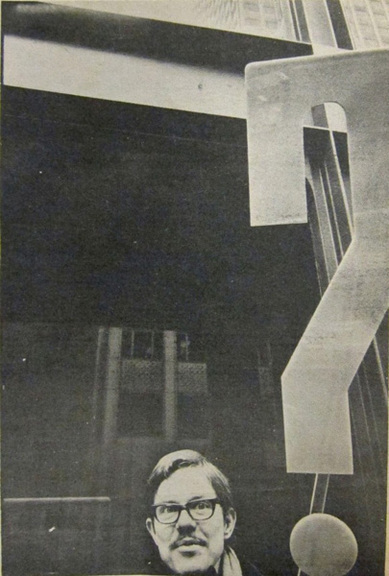Forelesning

Open Lecture: The Other Tradition
Curator and art historian Eva Fabbris will give an open lecture on the American art critic Gene Swenson and his theory of the other tradition which addresses the role of the observer in the work.
Most likely, the first person in the art world to actively express dissent against MoMA was, the American critic Gene R. Swenson when, in February 1968, he picketed outside the museum entrance for several weeks at regular hours, carrying a placard in the shape of a blue question mark. In 1966, Swenson - art historian and curator - galvanized the New York art scene with his theory of the Other Tradition, exhibited under the same title at the Institute for Contemporary Art in Philadelphia and in the accompanying catalogue. At a time when American criticism was just beginning to counter the hitherto dominant position of Clement Greenberg’s formalism, Swenson offered an alternative account of modernism. His intention was to reaffirm the historical and driving centrality of Dada and Surrealism. This act of rewriting of history belonged to a more general idea that Swenson had of art, largely founded on his view of Pop Art: Swenson was one of the first critics to recognize, as early as 1962, commonalities among the group he called "Sign Painters" for their aseptic use of pictorial signs. The ambition to employ mechanical reproduction and the choice of (perversely) recognizable and shared subject matter were the premises underpinning the production of artwork that, according to Swenson, allowed a kind of emancipation from the use of symbols and interpretations (as much for the artist as for their audience). The relationship between the work and the viewer could be based on an emotional sharing that would in and of itself be a principle of interpretation. According to Swenson, Pop made it possible for viewers to invest the work with their own subjectivity as never before. Western linguistics, logical thinking, do not convey ways of thought suitable to this transfer of subjectivity. "The Other Tradition" should be told in an ‘other’ language: Swenson identified two possible models for this language, complementary to each other, in Salvador Dalì and Marcel Duchamp.
Eva Fabbris (1979) lives in Milano. She is a curator and art historian. She obtained a PhD in Humanities from the Universita’ degli Studi di Trento. Since February 2016 she is part of the Curatorial and Research Department of Fondazione Prada in Milan. From 2013 to 2016 she was curator and coordinator of Back to the Future for Artissima, Turin. She worked in different curatorial departments in Italian museums (she was curatorial assistant at Museion in Bolzano, in 2008-09 and adjunct curator at Galleria Civica in Trento in 2009-10). She was co-curator at Kaleidoscope Project Space in Milan with Michele D'Aurizio in 2011-12 and then, as independent curator she took care of solo and group exhibitions for international institutions, among which the Nouveau Musée National de Monaco, Montecarlo, la galerie de l'erg, Brussels, Triennale di Milano and Fondazione Morra, Naples. As guest lecturer she gave talks and conversations in many museums and schools as Centre Pompidou, Paris, Daimler Foundation, Berlin, HEAD, Geneve, GAM, Turin and in Italian universities. She is co-editor of "Arrow of Time", the book recently published by Humboldt Books dedicated to filmmakers Yervant Gianikian and Angela Ricci Lucchi.
She contributes to Moussemagazine, L'Officiel Art Italia and Flash Art.
She has extensively worked with or addressed the work of Giorgio Andreotta Calò, Lupo Borgonovo, Marc Camille Chaimowicz, Anna Franceschini, Dora Garcia, Alberto Garutti, Yervant Gianikian e Angela Ricci Lucchi, Pierre Leguillon, Diego Marcon, Fausto Melotti, Brian O'Doherty, Alessandro Pessoli, Fabio Sandri, Paul Sietsema, Lucy Skaer among others.
